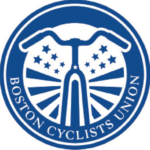How biking to Montreal changed my view of Boston’s bike infrastructure
By Alex Frieden
This past Spring, I signed up for Bostreal, a fundraising trip for the Boston Cyclists Union where 30 Bostonians bike 400 miles at the end of May from Boston to Montreal, both to support the work of the Bike Union and to experience Montreal’s excellent bike infrastructure.
During the day, I work in Cancer Diagnostics on the Longwood Medical Campus at a joint appointment for Dana Farber and Brigham and Women’s Hospital. Most nights you can find me doing advocacy for bikes, walkable streets, and places for people in the trifecta that is Boston/Cambridge/Somerville. I currently lead the Somerville Bike Committee Evaluation and Planning Group which helps me think about what mix of infrastructure should exist on a street for all road users on a regular basis.
Basically, I’m a Batman bicycle vigilante saving and protecting the streets… one public meeting at a time. That is to say, I’m no stranger to bike advocacy, so it was quite a surprise to me that my experience biking in Montreal would be so powerful.
It’s important to remember why comparing Boston to Montreal is so pertinent: These are both old cities with roads that were laid out hundreds of years ago. Both cities have the handy work of Fredrick Law Olmsted, the landscape architect responsible for designing the Emerald Necklace in Boston and Mont Royal in Montreal. However, a crucial difference between the cities is that Montreal has already solved much of its transportation problems, and in ways Boston could emulate.
When it comes to the ideal concept of safe streets and bikeable cities, Montreal is at the top of the list. While Boston, Cambridge, and Somerville have all been implementing protected infrastructure for a short amount of time, and with great results, Montreal has been installing various types of bike infrastructure throughout the city since the ’80s.
During our time in Montreal we learned about their history of bike activism, and we had the chance to tour their bike infrastructure network. Below is an example of one of a common site in Montreal, a two-way protected bike lane (or cycletrack)(picture to the right).
As pictured above, Montreal has implemented two-way cycletracks in many places. Montreal has also added bicycle traffic signals at a number of intersections, which allows cyclists to get a green light before motor vehicles. On the major arterials of the city, Montreal has engineered a “green wave” for people biking — which is a timing of traffic lights such that if you are going 20 mph on your bicycle when the first light turns green you will get all green lights on that stretch of road. In the US, “green waves” are typically designed for people driving cars. Below is an example of this green wave cycletrack that we got to see a tour of:
Montreal is now thinking about installing protected intersections to fully round out their cycling network. In 2016/2017, the city is working to complete 63 new bike infrastructure projects. This is the rate that Boston, Cambridge, and Somerville need to set their sites on if we want to create a connected network of bike infrastructure that is safe and comfortable for people of all ages and abilities. The “pilot projects” being implemented in the Boston area now are great, but implementing only 5-10 pilot projects a year is not enough.
On the political side, each neighborhood, or borough, of Montreal has control of a budget that they use to maintain their streets. In the Plateau-Mont-Royal borough, the local council implemented snow removal reform, which allowed them to allocate money to other projects and priorities. Some of that money was spent on cycletracks, parking studies, and new bike specific traffic signals. As a result they have seen huge increase in numbers of riders: Montreal has seen bicycle ridership of 120,000 riders a day based on its Velo Quebec Survey.
While Montreal has created a number cycletracks and protected bike lanes, they have also done a great job with contraflow streets: These are streets that are one way except for bikes that are allowed to go the opposite way in a designated area. One such example:
This is a one-way road where there is parking on one side, a bike lane, then a buffered contraflow lane.
In addition to the tour and the chance to meet with local bike activists and politicians, we were also able to meet Dr. Patrick Morency, Professor at McGill School of Public Health. Dr. Morency studies traffic crashes and their causes. His research shows that wearing a helmet, which many of us would guess is the best way to prevent traumatic brain injuries, are not nearly as useful as protected bike infrastructure and separating people biking from moving cars and trucks. In fact, in terms of numbers, it is people inside automobiles who should be wearing helmets, as motor vehicle occupants suffered a higher rate of traumatic brain injuries than people biking during the study period.
In light of this, and based on the success Montreal has had in implementing a connected network of protected bike lanes, I now believe that the progress we’ve recently made in the Boston area is far too little, and at a much slower pace than we need in order to eliminate traffic fatalities and make greater Boston a truly safe and comfortable place to ride a bike for transportation.


Great article Alex!
Great article, Alex.
You should next go check out Vancouver, their non-motorized traffic infrastructure is even better–some of the best in the world I’ve ever seen.
As a side note, I was almost knocked off my bike yesterday on Beacon st when a daredevil driver attempted to squeeze between me and another car going 40mph. There’s no safety improvement like physically separated bike lines.
Wonderful and inspiring article – thanks!